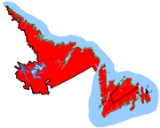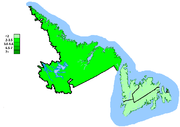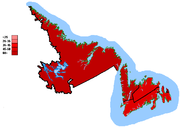
Canadian federal election results in Newfoundland and Labrador
Encyclopedia
| Electoral history | |
|---|---|
| 2011 | |
| 2008 | |
| 2006 | |
| 2004 | |
| 2000 | |
| 1997 Canadian federal election, 1997 The Canadian federal election of 1997 was held on June 2, 1997, to elect members of the Canadian House of Commons of the 36th Parliament of Canada. Prime Minister Jean Chrétien's Liberal Party of Canada won a second majority government... |
|
| 1993 Canadian federal election, 1993 The Canadian federal election of 1993 was held on October 25 of that year to elect members to the Canadian House of Commons of the 35th Parliament of Canada. Fourteen parties competed for the 295 seats in the House at that time... |
|
| 1988 Canadian federal election, 1988 The Canadian federal election of 1988 was held November 21, 1988, to elect members of the Canadian House of Commons of the 34th Parliament of Canada. It was an election largely fought on a single issue: the Canada-U.S. Free Trade Agreement .... |
|
| 1984 Canadian federal election, 1984 The Canadian federal election of 1984 was held on September 4 of that year to elect members of the Canadian House of Commons of the 33rd Parliament of Canada... |
|
| 1980 Canadian federal election, 1980 The Canadian federal election of 1980 was held on February 18, 1980 to elect members of the Canadian House of Commons of the 32nd Parliament of Canada... |
|
| 1979 Canadian federal election, 1979 The Canadian federal election of 1979 was held on May 22, 1979 to elect members of the Canadian House of Commons of the 31st Parliament of Canada. It resulted in the defeat of Liberal Party of Canada after 11 years in power under Prime Minister Pierre Trudeau. Joe Clark led the Progressive... |
|
Canadian federal elections have provided the following results in Newfoundland and Labrador.
Regional profile
Newfoundland and LabradorNewfoundland and Labrador
Newfoundland and Labrador is the easternmost province of Canada. Situated in the country's Atlantic region, it incorporates the island of Newfoundland and mainland Labrador with a combined area of . As of April 2011, the province's estimated population is 508,400...
has been a Liberal
Liberal Party of Canada
The Liberal Party of Canada , colloquially known as the Grits, is the oldest federally registered party in Canada. In the conventional political spectrum, the party sits between the centre and the centre-left. Historically the Liberal Party has positioned itself to the left of the Conservative...
heartland since it joined Canada in 1949, with only the city of St. John's
St. John's, Newfoundland and Labrador
St. John's is the capital and largest city in Newfoundland and Labrador, and is the oldest English-founded city in North America. It is located on the eastern tip of the Avalon Peninsula on the island of Newfoundland. With a population of 192,326 as of July 1, 2010, the St...
electing Progressive Conservative
Progressive Conservative Party of Canada
The Progressive Conservative Party of Canada was a Canadian political party with a centre-right stance on economic issues and, after the 1970s, a centrist stance on social issues....
s on a relatively consistent basis, and that support has transferred over to the current Conservative
Conservative Party of Canada
The Conservative Party of Canada , is a political party in Canada which was formed by the merger of the Canadian Alliance and the Progressive Conservative Party of Canada in 2003. It is positioned on the right of the Canadian political spectrum...
s. Even in the 1984 Mulroney landslide, more rural and remote seats went Liberal than PC. The Conservatives picked up one seat in the 2006 election, but the Liberals still hold a majority of the seats. Party preference here has a lot to do with religion, where Catholics tend to vote Conservative and Protestants Liberal (contrary to the rest of the country). In 2008, the Anything But Conservative
Anything But Conservative
Anything But Conservative , also known as the ABC campaign, was a political campaign in the 2008 Canadian federal election encouraging voters to support any party other than the federal Conservative Party...
movement took hold here and the Conservatives lost all their seats to the Liberals and NDP. In the 2011 election, Newfoundland and Labrador was the only province to have the Liberals win in terms of popular vote. They however did lose 2 seats, 1 to the Tories and one to the NDP. The final count is Liberals: 4, NDP: 2, Conservative: 1
2006 - 39th General Election
The Liberals won four seats and the Conservatives three. The open AvalonAvalon (electoral district)
Avalon is a federal electoral district in Newfoundland and Labrador, Canada, that has been represented in the Canadian House of Commons since 2004.-Demographics:Ethnic groups: Languages:² Unemployment: 25.9%...
seat changed hands from the Liberals to the Tories. The seat had been held by Natural Resources Minister John Efford
John Efford
Ruben John Efford, PC is a former Canadian politician.-Provincial politics:...
, who had retired. Otherwise, there was little change from the previous election.
2004 - 38th General Election
One of the biggest questions of the 2004 election was whether the new Conservative Party of Canada could match the old federal PC Party's level of support in Atlantic Canada. With Newfoundland and Labrador's provincial PC government unpopular over mandating an end to the previous year's public service strike, any province-wide success for 2004 was seen as unlikely. The Conservatives lost one of their three seats (previously gained in a byelection) and held their rump in St. John's. Des McGrath was seen as the NDP's best chance of electing a candidate in the province in several decades, but he still fell nearly 4000 votes short of winning Random—Burin—St. George's. |
|
 |
 |
 |
 |

